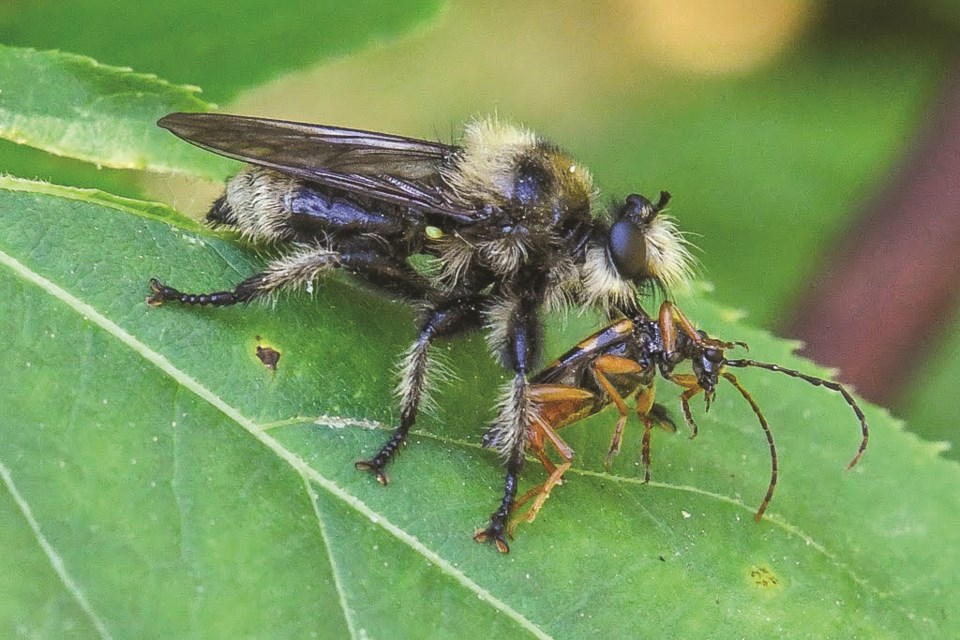I’ve found your newest favourite insects, the mosquito assassins, the hawks of the bug world—introducing robber flies! Belonging to family Asilidae, their common name comes from their ambush style of capturing prey. Even though I wasn’t familiar with these flies until two years ago, an initial interest has blossomed into an obsession.
When walking the local trails or in the backcountry I watch for robbers anywhere there are downed trees or rocks in open canopy areas. The more sunlight the better! Due to their high metabolism these furry flies need to keep their body temperature high in order to catch prey. If food is abundant then a high body temp is advantageous, as it increases the net energy gained from food. Another advantage of a warm body means it’s always ready for take off, which is beneficial for foraging, predator avoidance, and I assume, to catch a potential lover.
Prey is a mixture of insect orders. I’ve seen mosquitos, beetles, western honey bees, flies, butterflies, and wasps—all within the mouthparts of these voracious eaters. Wow! From what I’ve read the average daily intake ranges from six to 35 insects.
Robber flies have adapted traits perfect for attacking prey mid-air and for a quick meal time. They do so from behind so that when attacking a stinging insect the robber fly itself doesn’t get stung. Makes sense. Built tough, these flies are equipped with a sucking mouthpart called a hypopharynx that—while short—is sharp and lethal which delivers a dose of paralyzing saliva. Once the prey’s juicy bits are liquified through a second injection of different enzymes, the contents are sucked up via the proboscis and into its digestive system. They even have a little moustache! The mystaxis is a small set of stiff hairy bristles on their face which are helpful when consuming rambunctious prey. Adorable and useful!
Most robbers are generalists, but some have greater prey preference than others, which is reflected in their body shape. Some are slender, others are bulky, which is evidence of evolution at work. Using the “Explore” tab on iNaturalist.ca will show the diversity of shapes, sizes, colours and fluffiness—my favourite physical characteristic. Genus Laphria, the bee-mimics, are one part savage and one part fuzzy-wuzzy bee impersonator. Cyrtopogons are slender, black and grey, and from my observations the most common around Pemberton. Whereas Stenopogonini have long, skinny, orange legs that give them a low and stable profile, perfect for this ambush predator.
Interactions like the robber fly capturing its prey occur right beside us constantly! The ecology of the Sea to Sky is fascinating, especially among insects.
But as insect populations plummet across the globe, how will interactions between robbers and their prey change? Will future heat waves be beneficial for these heat lovers? Will warmer temperatures reduce mosquito breeding sites? Recognizing and appreciating the insects that help construct our neighbourhood habitats is one piece of the puzzle in keeping our local and global ecosystem services intact.
Personally, I always want to know these buddies are out there (sustainably) putting a small dent in the nearby mosquito population. Thanks robbers!
You can find out more here.
Naturespeak is prepared by the Whistler Naturalists. To learn more about Whistler’s natural world, go to whistlernaturalists.ca.





